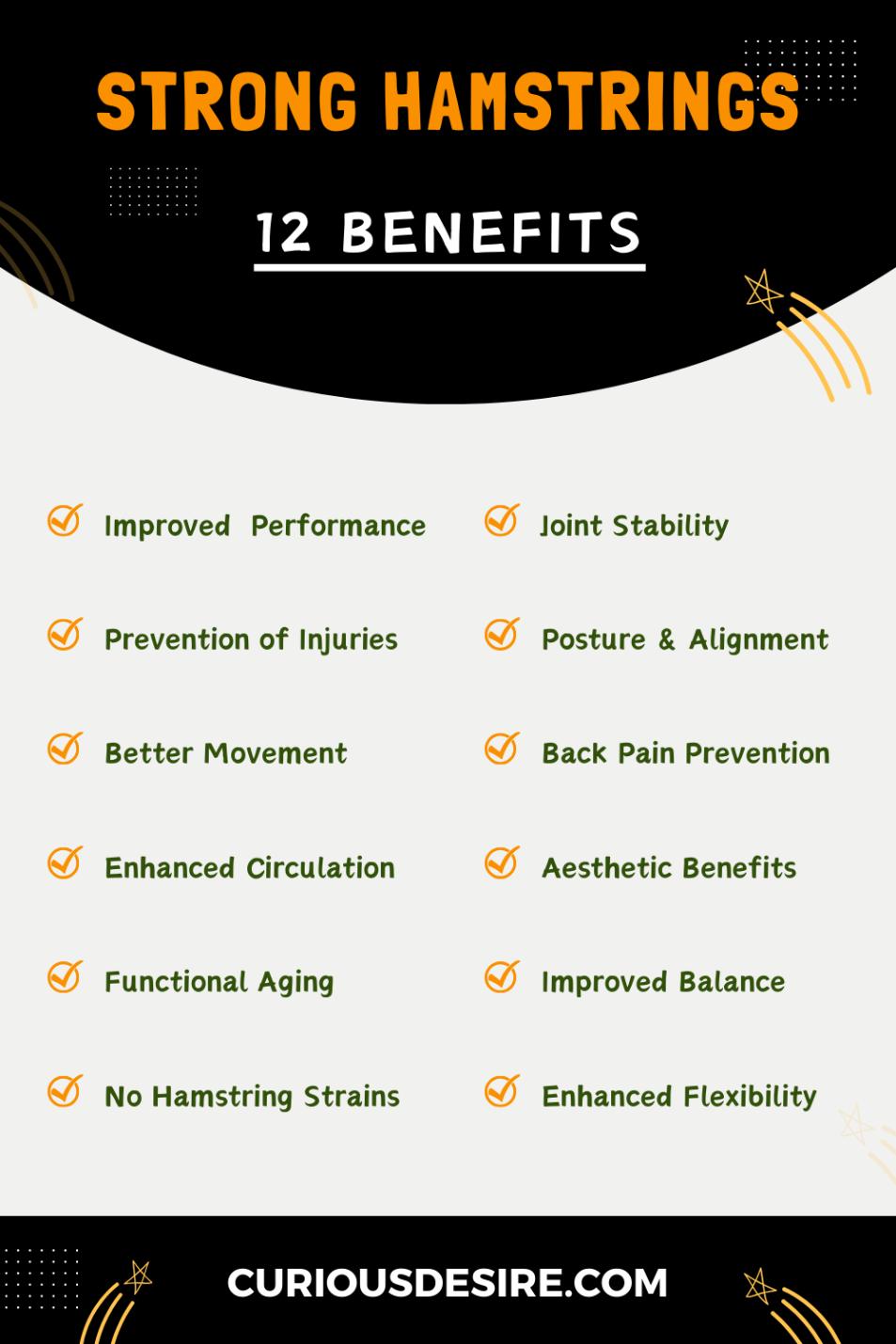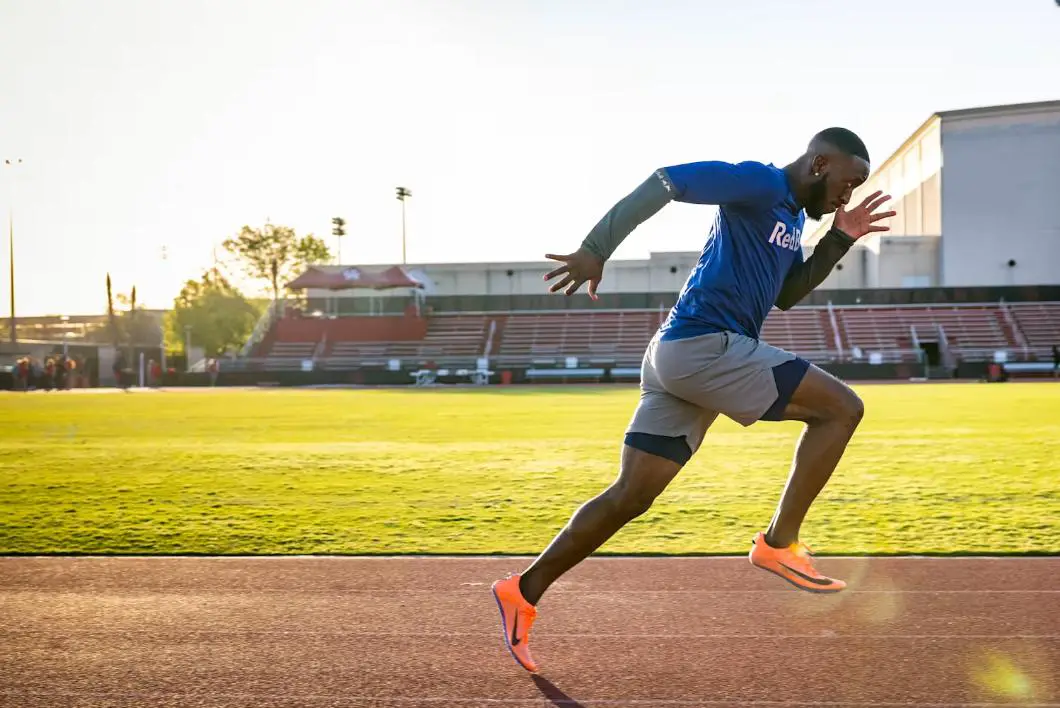The hamstrings are important muscles in our bodies that can significantly impact the quality of our lives.
When they are strong, life becomes much better because they don’t just help us at a young age; their benefits stick around as we get older.
Today, we’ll look at some of the benefits of this important muscle group to encourage you to take good care of their strength. Let’s get started!
Here are the top 5 benefits of strong hamstrings:
- Joint Stability
- Aesthetic Benefits
- Back Pain Prevention
- Posture and Alignment
- Prevention of Injuries
[toc]

Benefit 1: Improved Athletic Performance
Strong hamstrings significantly improve athletic performance by enhancing speed, power, and agility.
When hamstrings are strong, they play a crucial role in propelling your body forward during activities such as running and jumping, a concept similarly emphasized by LIVESTRONG.COM.
Additionally, athletes engaging in sports requiring sudden stop starts, and direction changes, such as basketball or soccer, benefit from the stability provided by strong hamstrings, reducing the risk of injuries associated with these dynamic movements.
Benefit 2: Joint Stability
Studies mention that the hamstrings play a key role in stabilizing important joints, particularly the knee and hip.
Strong hamstrings act as support structures, ensuring that these joints remain steady during various physical activities.
This stability is essential for preventing injuries, especially during sports or exercises that involve quick changes in direction.
By providing support to the knee and hip, strong hamstrings contribute to overall joint health and reduce the likelihood of strains and sprains.
Benefit 3: Prevention of Injuries
Weak hamstrings can lead to an increased risk of injuries, particularly in the knee and lower back.
Strengthening these muscles helps maintain a balance between the front (quadriceps) and back (hamstrings) of the thigh.
This balance is crucial for preventing anterior cruciate ligament (ACL) injuries in the knee, a common concern for athletes.
Additionally, strong hamstrings provide support to the lower back, reducing the risk of strains and discomfort associated with poor muscle balance.
Benefit 4: Posture and Alignment
The strength of your hamstrings directly influences your posture and spinal alignment. Well-developed hamstrings contribute to pelvic stability, ensuring that your spine maintains a natural curvature.
This stability is vital for good posture and preventing issues such as slouching or excessive arching of the lower back.
By preventing hyperextension of the knee joint, strong hamstrings also contribute to a more stable and aligned body position.
Benefit 5: Functional Movement
Strong hamstrings make daily activities easier and more efficient. Walking, climbing stairs, and bending at the waist all involve the use of these muscles.
When your hamstrings are well-conditioned, these movements become smoother and less taxing on your body.
Additionally, the flexibility gained from strong hamstrings enhances your overall range of motion, making it easier to perform various activities with comfort and ease.

Benefit 6: Back Pain Prevention
The support provided by strong hamstrings extends to the lower back, reducing the risk of discomfort and pain.
By helping to maintain proper pelvic alignment and evenly distributing the load on the spine, these muscles contribute to a healthier lower back.
Imbalances between the hamstrings and quadriceps can lead to back pain, and strengthening the hamstrings helps address this issue by promoting a more even muscle balance.
Benefit 7: Enhanced Circulation
Engaging the hamstrings in exercises promotes better blood circulation in the lower extremities.
This is particularly important for preventing issues such as deep vein thrombosis, which can arise from prolonged periods of inactivity.
Improved circulation ensures that oxygen and nutrients reach the muscles efficiently, supporting their function and overall health.
Benefit 8: Aesthetic Benefits
Beyond functionality, strong hamstrings contribute to a toned and defined appearance in the legs.
These muscles add shape and contour, enhancing the overall symmetry of the lower body.
For individuals seeking a sculpted and athletic look, developing strong hamstrings is essential.
Benefit 9: Functional Aging
As individuals age, maintaining mobility and independence becomes crucial for a healthy lifestyle.
Strong hamstrings play a role in preserving mobility by supporting functional movements.
Whether it’s getting up from a chair or walking comfortably, well-conditioned hamstrings contribute to a more active and independent lifestyle as we age.
Benefit 10: Improved Balance and Coordination
Strong hamstrings contribute to better balance and coordination. These muscles work in conjunction with other stabilizing muscles to keep you steady on your feet.
Enhanced balance is especially important during activities that require you to stand on one leg or navigate uneven surfaces.
This benefit extends beyond athletic performance, impacting everyday tasks like walking on uneven terrain or maintaining stability while reaching for objects.
Benefit 11: Reduced Risk of Hamstring Strains
Strong hamstrings are more resilient and less prone to strains. Regular strength training not only builds muscle but also improves the integrity of the muscle fibers and connective tissues.
This increased resilience reduces the likelihood of hamstring strains, a common injury, especially in activities involving sudden accelerations or decelerations.
Benefit 12: Enhanced Flexibility and Range of Motion
While strength is crucial, the hamstrings also benefit from improved flexibility.
Strong and flexible hamstrings allow for a greater range of motion in the hip joint.
This increased flexibility is beneficial for activities that require extensive hip movement, such as kicking in sports like soccer or martial arts.
It also contributes to better overall joint health and can alleviate stiffness associated with a sedentary lifestyle.
Strong Hamstrings Benefits FAQs
1. Why is it important to have strong hamstrings?
Having strong hamstrings is crucial for overall lower body function and stability.
These muscles play a key role in supporting the knee and hip joints, contributing to joint stability and preventing injuries.
Additionally, strong hamstrings are essential for various physical activities, including running, jumping, and lifting, as they provide the necessary power and propulsion for these movements.
Good hamstring strength also supports proper posture, and spinal alignment, and reduces the risk of lower back pain.
2. What happens if you have strong hamstrings?
When you have strong hamstrings, you experience improved athletic performance, enhanced joint stability, and a reduced risk of injuries.
Strong hamstrings contribute to better posture, pelvic stability, and overall functional movement.
Additionally, these muscles support the lower back and play a role in preventing muscle imbalances that can lead to discomfort or pain.
3. Does having strong hamstrings make you faster?
Yes, having strong hamstrings can contribute to increased speed. Strong hamstrings provide the necessary power for explosive movements, such as sprinting.
The ability to generate force efficiently from the hamstrings allows for a more powerful push-off during running, resulting in greater speed and acceleration.
4. What are the health benefits of hamstrings?
The health benefits of strong hamstrings include improved joint stability, reduced risk of injuries (especially in the knee and lower back), enhanced posture, and better overall functional movement.
Strong hamstrings also support circulatory health by promoting blood flow in the lower extremities, contributing to overall cardiovascular well-being.
5. Do hamstrings make glutes look bigger?
While hamstrings themselves may not directly make the glutes look bigger, they contribute to overall lower body development.
Well-developed hamstrings, when combined with targeted glute exercises, can enhance the overall shape and appearance of the buttocks.
A balanced lower body workout that includes both hamstrings and glute exercises can create a more sculpted and proportionate look.
6. Why do people have weak hamstrings?
Weak hamstrings can result from various factors, including lack of exercise, a sedentary lifestyle, muscle imbalances, or improper training techniques.
Additionally, certain conditions or injuries may contribute to hamstring weakness.
People who predominantly focus on quadriceps exercises without balancing with hamstring exercises may also develop muscle imbalances.
7. How do you know if you have strong hamstrings?
Signs of strong hamstrings include improved athletic performance, the ability to perform activities like running and jumping with ease, good posture, and reduced risk of lower back pain.
Strength assessments, such as the ability to lift weights during hamstring exercises like deadlifts, can also indicate hamstring strength.
8. What happens when hamstrings are stronger than quads?
Muscle imbalances between stronger hamstrings and weaker quadriceps can lead to issues like knee instability.
The quadriceps and hamstrings work together to support the knee joint, and an imbalance may increase the risk of injuries, such as anterior cruciate ligament (ACL) strains.
9. Are weak hamstrings genetic?
While genetics can play a role in muscle development, weakness in the hamstrings is often influenced by lifestyle factors, exercise habits, and overall health.
Genetic predisposition may contribute to individual variations in muscle strength, but it’s not the sole determining factor.
10. Why do footballers have weak hamstrings?
Footballers may develop weak hamstrings due to imbalances in training routines.
The emphasis on quick, explosive movements and frequent running can sometimes neglect the development of hamstring strength.
Additionally, inadequate warm-up, improper conditioning, and insufficient recovery may contribute to hamstring weakness in footballers.
11. How do you fix weak hamstrings?
To address weak hamstrings, incorporate a well-rounded exercise routine that includes hamstring-focused exercises such as deadlifts, hamstring curls, and lunges.
Strengthening exercises should be balanced with stretching and flexibility training to ensure a comprehensive approach.
Consulting with a fitness professional can help create a tailored workout plan to target and strengthen weak hamstrings.
12. Why do runners have weak hamstrings?
Runners may develop weak hamstrings due to the repetitive nature of running, which primarily engages the quadriceps and calves.
Insufficient attention to hamstring-specific exercises and imbalances in training can lead to weakened hamstrings.
Including targeted hamstring exercises and cross-training activities that address overall lower body strength can help prevent and address hamstring weakness in runners.